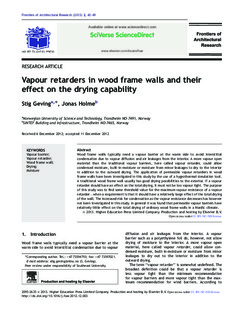| dc.contributor.author | Geving, Stig | |
| dc.contributor.author | Holme, Jonas | |
| dc.date.accessioned | 2017-11-07T08:28:01Z | |
| dc.date.available | 2017-11-07T08:28:01Z | |
| dc.date.created | 2013-07-23T09:52:55Z | |
| dc.date.issued | 2013 | |
| dc.identifier.citation | Frontiers of Architectural Research. 2013, 2 (1), 42-49. | nb_NO |
| dc.identifier.issn | 2095-2635 | |
| dc.identifier.uri | http://hdl.handle.net/11250/2464426 | |
| dc.description.abstract | Wood frame walls typically need a vapour barrier at the warm side to avoid interstitial condensation due to vapour diffusion and air leakages from the interior. A more vapour open material than the traditional vapour barriers, here called vapour retarder, could allow condensed moisture, built-in-moisture or moisture from minor leakages to dry to the interior in addition to the outward drying. The application of permeable vapour retarders in wood frame walls have been investigated in this study by the use of a hygrothermal simulation tool. A traditional wood frame wall usually has good drying possibilities to the exterior. If a vapour retarder should have an effect on the total drying, it must not be too vapour tight. The purpose of this study was to find some threshold value for the maximum vapour resistance of a vapour retarder—when a requirement is that it should have a relatively large effect of the total drying of the wall. The increased risk for condensation as the vapour resistance decreases has however not been investigated in this study. In general it was found that permeable vapour barriers have relatively little effect on the total drying of ordinary wood frame walls in a Nordic climate. | nb_NO |
| dc.language.iso | eng | nb_NO |
| dc.publisher | Elsevier | nb_NO |
| dc.rights | Attribution-NonCommercial-NoDerivatives 4.0 Internasjonal | * |
| dc.rights.uri | http://creativecommons.org/licenses/by-nc-nd/4.0/deed.no | * |
| dc.title | Vapour retarders in wood frame walls and their effect on the drying capability | nb_NO |
| dc.type | Journal article | nb_NO |
| dc.type | Peer reviewed | nb_NO |
| dc.description.version | publishedVersion | nb_NO |
| dc.source.pagenumber | 42-49 | nb_NO |
| dc.source.volume | 2 | nb_NO |
| dc.source.journal | Frontiers of Architectural Research | nb_NO |
| dc.source.issue | 1 | nb_NO |
| dc.identifier.doi | 10.1016/j.foar.2012.12.003 | |
| dc.identifier.cristin | 1039930 | |
| dc.description.localcode | Copyright © 2013 Higher Education Press Limited Company. Production and hosting by Elsevier B.V. Open access underCC BY-NC-ND license. | nb_NO |
| cristin.unitcode | 194,64,91,0 | |
| cristin.unitname | Institutt for bygg- og miljøteknikk | |
| cristin.ispublished | true | |
| cristin.fulltext | original | |
| cristin.qualitycode | 1 | |

